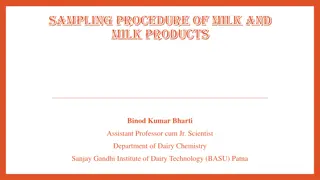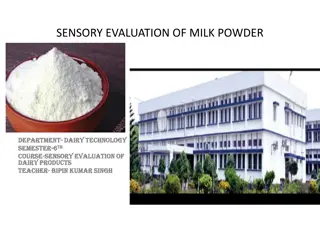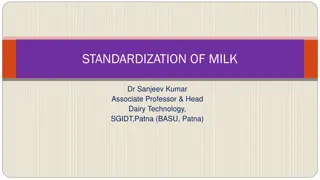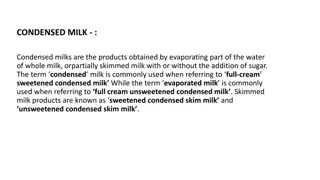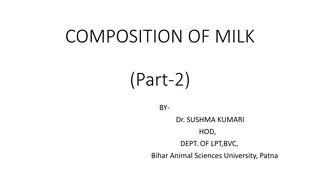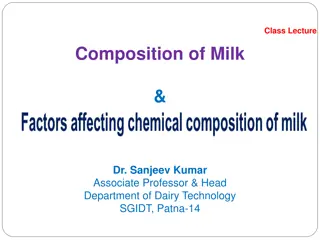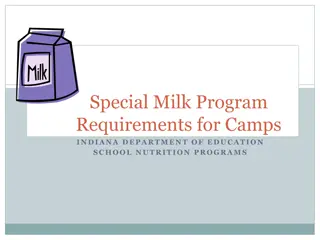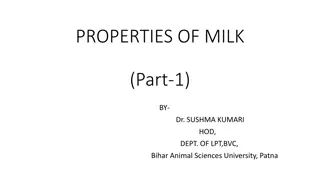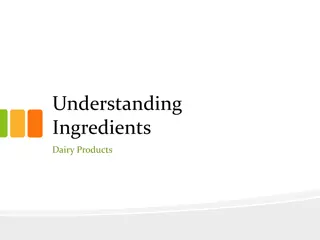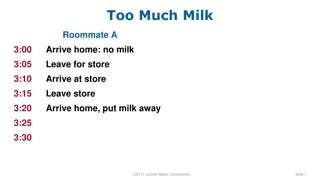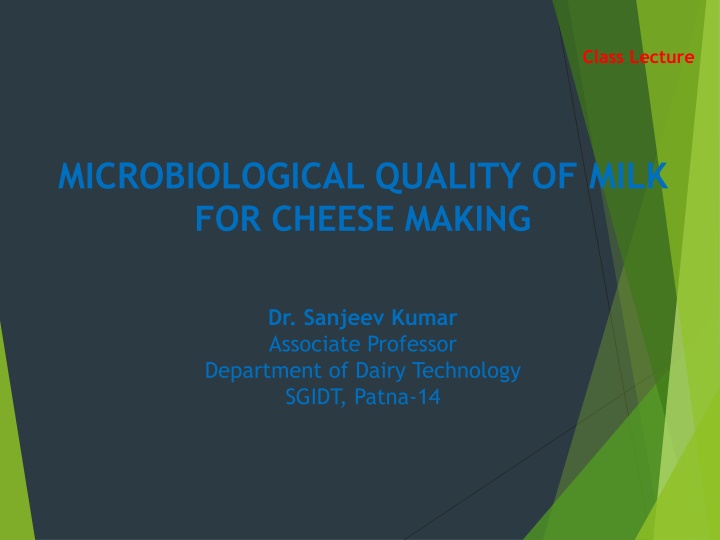
Microbiological Quality of Milk for Cheese Making - Importance and Considerations
Explore the importance of microbiological quality of milk for cheese making, including the impact of microorganisms on milk composition and product quality. Learn about the risks associated with raw milk contaminants, such as psychotropic bacteria and somatic cells, and the effects of inhibitors like antibiotic residues and disinfectants. Understand how these factors can influence the process and outcome of cheese production.
Download Presentation

Please find below an Image/Link to download the presentation.
The content on the website is provided AS IS for your information and personal use only. It may not be sold, licensed, or shared on other websites without obtaining consent from the author. If you encounter any issues during the download, it is possible that the publisher has removed the file from their server.
You are allowed to download the files provided on this website for personal or commercial use, subject to the condition that they are used lawfully. All files are the property of their respective owners.
The content on the website is provided AS IS for your information and personal use only. It may not be sold, licensed, or shared on other websites without obtaining consent from the author.
E N D
Presentation Transcript
Class Lecture MICROBIOLOGICAL QUALITY OF MILK FOR CHEESE MAKING Dr. Sanjeev Kumar Associate Professor Department of Dairy Technology SGIDT, Patna-14
Microorganisms in Raw Milk According to the main points of attack on the major milk constituents, the saprophytic bacteria --- subdivided as follows: The change in milk composition may interfere with manufacture, if fermentation manufacture process, and this may affect the yield and quality of the product. --- involved in the The flavor of the raw milk may be adversely influenced (e.g. rancidity) and this may directly affect the flavor of the product e.g. Cottage cheese. Heat-stable bacterial enzymes may continue to act in the product, particularly during long storage, and adversely affect the stability and/or flavor of cream and UHT milk.
Clean milk secreted from the udder of the healthy animal contains only few numbers of microorganism (< 10,000/ml). Milk obtained from mastitis cow may contain high numbers of microorganism as well as leucocytes depending on the severity of infection Milk --- held at around 4 C during transport an in cheese plant.
Milk stored under such conditions contains predominantly psychotropic bacteria (over one million/ml). The Aeromonas, Alcaligenes, lactic acid bacteria, gram positive spore formers, coryne form group, enterococci and coli forms. Somatic Cells Milk used for preparation of cheese --- from healthy animal with a somatic cell count of < 50,000/ml common genera encountered---Pseudomonas, If raw milk contains > 50,000 somatic cells/ml results in phagocytosization of lactic acid bacteria (LAB) leads To slow starter activity in cheese vat, increase in rennet clotting time causing decreased curd firmness and a loose final body and texture.
Antibiotic Residues Antimicrobial agents administered to cows in the course of lactation can pass to milk in various levels and inhibit starter activity Disinfectants and Preservatives Quaternary ammonium compounds (QAC s) present more potential problems, because they maintain activity in milk, and LAB -- sensitive to low concentrations. Amount of chemical sanitizer that might enter milk through lack of rinsing should not be sufficient to cause culture inhibition. Bacteriophages Bacteriophagic infection of starter cultures --- result in failure of the fermentation and loss of product
Raw Milk Associated Inhibitors: Lactoperoxidase system --- the most significant microbial inhibitor in raw milk, but the presence of agglutinins -- an important problem in acid-coagulated cheeses. Other naturally occurring microbial inhibitors in milk include lysozyme and lactoferrin
CHILLING,STORAGE,CLARIFICATIO N AND BACTOFUGATION
Chilling and Cold Storage Raw milk --- sometimes cooled to about 4oC and Stored in refrigerated tanks or storage tanks prior to its conversion into cheese. Many properties change significantly like rennet coagulation time, firmness, moisture retention etc. Rennet coagulation time increases, firmness decreases and moisture retention increases due to cold storage of milk
Technological properties as a result of chilling and cold storage of the raw milk-- improved by adopting measures 1. Acidification of cheese milk with lactic acid to pH 6.5 2. Addition of calcium chloride @ 0.02% 3. Addition of more rennet within permissible limits 4. Use of higher renneting temperature 5. Use of higher cooking temperatures
Clarification Clarification --- one of the centrifugal processes Used to remove leukocytes, cellular debris and particles from earth or fodder gaining entry into milk Clarification Decreases the tendency of fat to form aggregates on standing Increases the rate of multiplication of starter organisms May increase the fat losses in whey and May also decrease the moisture and yield of cheese
Bactofugation The bactofuge system ---used in the cheese industry to remove spores from cheese milk that could cause late fermentation in semi-hard cheeses. Effect of bactofugation on cheese making : Effective method for preventing late blowing defect in semi-hard or hard varieties of cheeses as mainly due to removal of anaerobic microorganisms Facilitates reduction or elimination in the use of nitrates (nitrates are added to prevent late fermentation in cheese) Weakens the coagulum during cheesemaking which ---- overcome by addition of calcium chloride






